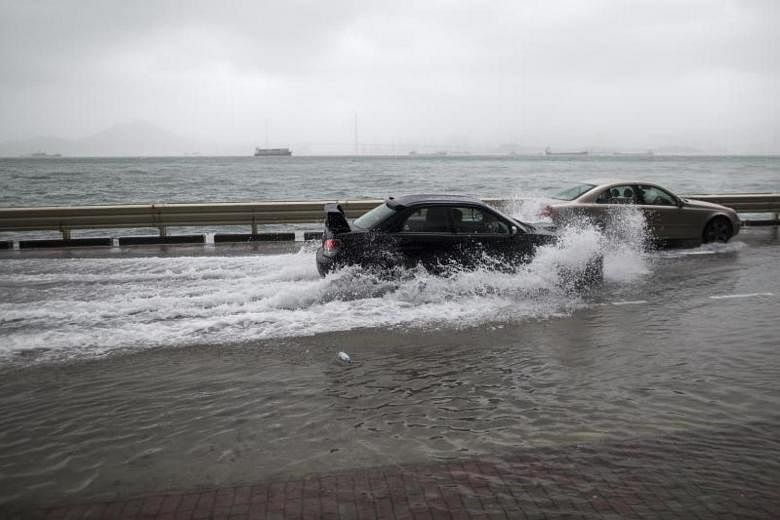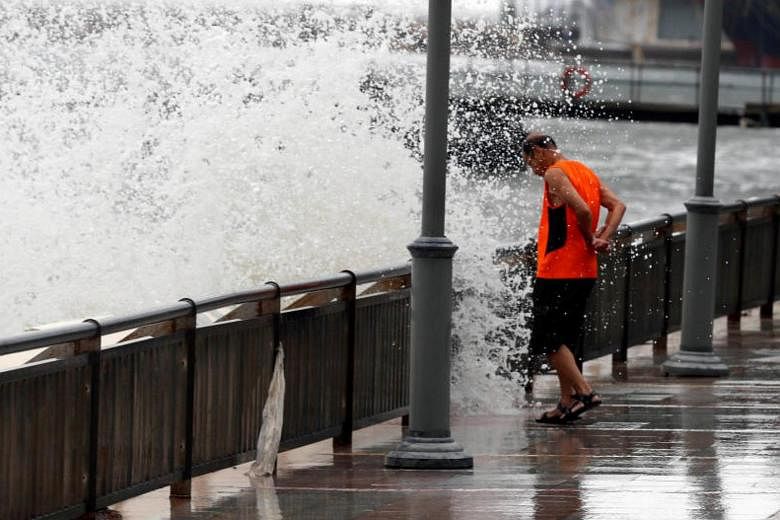HONG KONG (AFP) - Hong Kong's weather observatory raised on Wednesday (Aug23) the storm warning or Typhoon Hato to the city's maximum Typhoon 10 signal - meaning hurricane force winds are expected. Residents are glued to updates from the historic observatory which has the power to shut down the city with a signal.
Early on Wednesday (Aug 23), the observatory issued Hong Kong's highest level Typhoon 10 warning, bringing the city to a standstill with schools shut, hundreds of flights cancelled, and the stockmarket closed.
Founded in 1883, when Hong Kong was a British colony, the observatory originally used harbourside cannon to notify mariners of a storm's arrival.
It then developed a numeric warning system - with a T1 being the weakest and T10 the most powerful - which celebrated its 100th anniversary this year and is still in use.
When the system was introduced, massive iron symbols indicating a storm's severity were hoisted from coastal hillsides.
Now, residents receive those warnings via the official MyObservatory app, downloaded 6.5 million times since it was launched in 2010, in a city of 7.3 million.
Complete with a typhoon tracker, a nine-day forecast and frequent push notifications on temperature and wind speed, the observatory's forecasts are much discussed by residents and regularly provoke a visceral reaction.
Certain severe weather warnings mean compulsory shutdowns and prompt complaints from businesses over lost earnings.
On the flip-side, some workers keen for a day off accuse the observatory of shying away from issuing notices that would affect trade on week days.
"You'll always check it to see if there is a chance to have a holiday," said 24-year-old office assistant Levi Sin.

'Don't cry wolf'
The meteorologist at the helm of the observatory, director Shun Chi Ming, is personally responsible for issuing Hong Kong's typhoon signals.
He says it is important for forecasters not to "cry wolf", so that residents take the warning seriously.
"When I was a young forecaster, we got a satellite image of the area once every three hours... Now we have an image every 10 minutes," he adds.
The strongest three storm warnings - T8, T9 and T10 - trigger citywide closures of schools, businesses and the stock market as well as widespread transport disruption.
"The whole city closes down because of my signature," says Shun, who sees the responsibility as a way to connect with residents.
"I have a very close engagement with the public," he explains, but admits he relishes the chance to raise the most severe warnings.
"The number 10 signal is one of my best times - some of our directors didn't get a chance to issue a number 10 ever," Shun said.
The last time he did so was for Typhoon Vicente in 2012.

Weather frontline
The white porticoed 19th century building which serves as the observatory's headquarters has been officially declared a historic monument and sits atop a hill in the shopping district of Tsim Sha Tsui where there was once a clear vantage point of the harbour.
It is now sandwiched between commercial and residential towers, with a newer adjoining block packed with wall-to-wall touchscreens displaying information from radar stations perched on some of Hong Kong's highest mountain peaks.
At the weather frontline are the radar specialists operating the observatory's remote lookouts.
Its highest weather station stands on Hong Kong's tallest peak, Tai Mo Shan, literally translated as "Big Hat Mountain", often shrouded in cloud, rain and wind.
It is usually unmanned but if a typhoon is predicted, radar workers make the 950-metre climb to ensure they can fix any damaged equipment.
Specialists at Tai Mo Shan can spend up to four days sleeping in foldout beds next to radar screens as a storm hits.
Ip Wing Sing, a senior radar mechanic who has worked for the observatory for 20 years, said the experience can be dramatic, to the distress of the workers' loved ones.
Ip once had to fix a radar during a Typhoon 10.
"The sounds of the wind and rain were very strong," Ip said.
"Your family will always want you to be safely at home when there's a typhoon."
The city saw its strongest storm in 1962 when the eye of typhoon Wanda passed over and gusts of 284 kmh were recorded.
It killed 130 people and destroyed thousands of residential huts, leaving 72,000 people homeless.
Since then, Hong Kong has adapted to typhoons, including making sure its highest commercial skyscrapers can sway in the wind.
A massive drainage tunnel running along most of Hong Kong Island was also completed in 2012 to alleviate seasonal flooding caused by heavy rain and typhoons.
Despite the improved conditions, Shun still sees the observatory as an integral part of Hong Kong.
"Whether kids need to go to school, or people should go to work - that all depends on the information from the observatory," he says.
Sceptical resident Sin disagrees.
"I think residents can more accurately predict the weather just by looking at the sky," he says.








